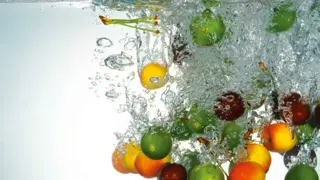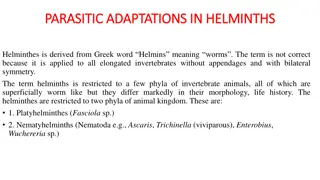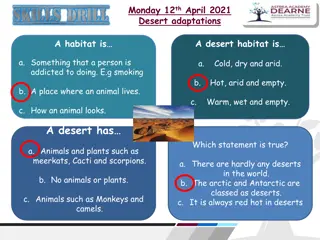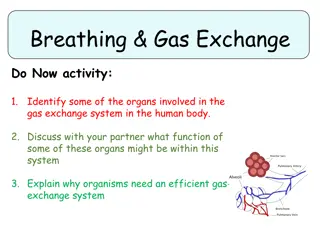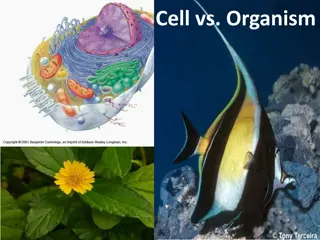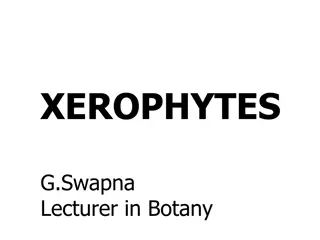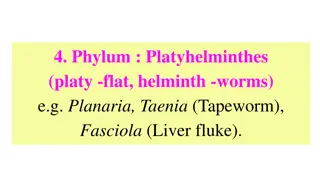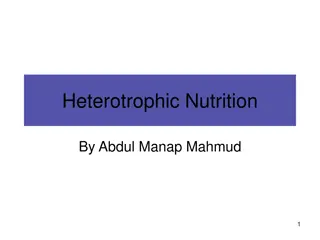Adaptations for Efficient Material Exchange in Organisms
Understanding how cells and organisms adapt for effective material exchange through diffusion, surface area to volume ratio, and specialized exchange surfaces. Larger organisms require specialized structures for efficient exchanges, in contrast to smaller organisms that can rely on simple diffusion. The surface area to volume ratio plays a crucial role in determining the effectiveness of material exchange in organisms as they grow larger.
- Organism adaptations
- Material exchange
- Diffusion adaptations
- Surface area
- Specialized exchange surfaces
Download Presentation

Please find below an Image/Link to download the presentation.
The content on the website is provided AS IS for your information and personal use only. It may not be sold, licensed, or shared on other websites without obtaining consent from the author. Download presentation by click this link. If you encounter any issues during the download, it is possible that the publisher has removed the file from their server.
E N D
Presentation Transcript
Exchanging Materials Do now activity: 1. What adaptations might cells have to increase the rate of diffusion? 2. Why might the size of an organism effect how quickly it is able to exchange substances with the outside world?
Progress indicators GOOD PROGRESS: To describe how surface area : volume ratio varies depending on the size of an organism To identify why larger, multicellular organisms need specialised exchange surfaces OUTSTANDING PROGRESS: To explain the adaptations you might expect to see in organisms that have effective gas exchange systems.
Look at the two organisms below, how might they differ in terms of how they take in oxygen? O2 CO2 CO2 O2 O2 Amoeba Polar Bear The amoeba has a large surface area compared to it s volume, this organism can rely on simple diffusion, osmosis and active transport to exchange materials with the outside world. The polar bear is a large, complex organism and can t rely simply on diffusion to supply all it s cells with the materials they need. These types of organism have adapted to have specialised exchange surfaces.
Surface area to volume ratio The surface area to volume ratio of an organism is very important, it makes a difference to the way an organism can exchange substances. The ratio of surface area to volume falls as objects get bigger Task: Have a go at completing the values for cubes 2 & 3 3 cm 2 cm 1 cm SA: 6cm2 Volume: 1cm3 SA: Vol = 6:1 SA: ____ Volume: ____ SA: Vol = ____ SA: ____ Volume: ____ SA: Vol = ____
Self-assessment: 3 cm 2 cm 1 cm SA: 6cm2 Volume: 1cm3 SA: Vol = 6:1 SA: 24cm2 Volume: 8cm3 SA: Vol = 3:1 SA: 54cm2 Volume: 27cm3 SA: Vol = 2:1 As organisms get bigger, the surface area to volume ratio falls. As the distances between the centre of the organism and the surface get bigger, simple diffusion is no longer enough to exchange materials between cells and the environment.
Adaptations for exchanging materials Think > Pair > Share: Think about the images above, how might they be adapted to exchange substances? Share you ideas with your partner!
Some common features of an exchange surface are the following: 1. 2. 3. A large surface area over which exchange can take place A thin membrane or being thin to provide a short diffusion path In animals, an efficient blood supply moves the diffusing substances away from the exchange surface to maintain a steep concentration gradient. In animals, being ventilated makes gas exchange more efficient by maintaining a steep concentration gradient. 4.
Task:Use information around the room to answer these questions Villi Structure and function Alveoli Structure and function 1. What are villi and where are they found? 1.Where are alveoli found in the body? Why can they be described as an exchange surface 2. Draw and label a diagram of a villi to clearly show three structural features which enable it to carry out it s function 2.Draw and label a diagram of an alveoli to clearly show three structural features which enable it to carry out it s function 3. Muscles, in the walls of the small intestine, keep the food inside it moving along. Blood, flowing in the capillaries inside the villi, keeps taking absorbed nutrients away. How do these two processes maintain a diffusion gradient for nutrients, so they keep diffusing from the intestine and into the blood? 3.What is an example of a COPD? How do these problems lead to symptoms such as breathlessness? Challenge: How is a concentration gradient maintained in the alveoli to ensure efficient exchange of oxygen and carbon dioxide? Challenge: Read through the Stop and think.. box on your worksheet, discuss with your peers and note down your ideas.
Peer-assess! Swap your work with your partner, we are going to go through the answers. Make sure you MARK and CORRECT your partners work.
Villi 1. These are finger-like projections which cover the inside of your small intestine, this is where all nutrients from your digested food are absorbed into the blood. 2. The structural features of villi: 3. Nutrients are constantly brought to the intestine, while those which have been absorbed are taken away. This maintains a concentration gradient where there is a higher concentration of the nutrient inside the intestine and a lower concentration in the blood. The nutrient therefore diffuses into the blood down the concentration gradient Very thin wall, one cell thick Thousands of tiny villi huge surface area Extensive blood capillary network to carry away absorbed nutrients
Alveoli 1. The alveoli are found in the lungs. They can be described as an exchange surface because they oxygen diffuses into the blood and carbon dioxide diffuses out. 2. The structural features of alveoli: The rich blood supply allows a constant flow of blood around the lungs which maintains a concentration gradient. 3. Examples of COPD include bronchitis and emphysema. Can be caused by smoking, this leads to inflammation in the lungs which permanently changes the tissue. Thickened walls of the airways and a build up of mucus makes gas exchange difficult, leading to breathlessness The total surface area of the alveoli can range from 30-50 square metres. This provides a huge surface area for gas exchange to occur. This moist lining also stops the alveolus from drying and cracking.
Exit Card! On your exit card write: 3 key words you have learnt this lesson One fact One question to test the knowledge of your classmates!
Exit Card Exit Card 3 key words: _____________________________ _____________________________ One fact: _____________________________ _____________________________ One question: _____________________________ _____________________________ 3 key words: _____________________________ _____________________________ One fact: _____________________________ _____________________________ One question: _____________________________ _____________________________ Exit Card Exit Card 3 key words: _____________________________ _____________________________ One fact: _____________________________ _____________________________ One question: _____________________________ _____________________________ 3 key words: _____________________________ _____________________________ One fact: _____________________________ _____________________________ One question: _____________________________ _____________________________
The exchange surface in the small intestine The inside of your small intestine is covered with thousands of tiny finger-like projections, called villi. This is where all the nutrients from your digested food are absorbed into the blood. The villi help this to happen quickly because they have a huge surface area. If the intestine had a smooth lining, fewer nutrients would be able to move across at the same time absorption would take much longer. Each villus contains a network of tiny blood capillaries. The blood is constantly on the move, carrying away dissolved nutrients. Some of the nutrients move into the villi by diffusion. They can do this if their concentration in the digested food, inside the intestines, is higher than the concentration in the blood. The villi have very thin walls, this makes the diffusion pathway short. To summarise, the lining of the small intestine is a good exchange surface: Huge surface area, produced by thousands of villi The villi have thin walls, short diffusion pathway Villi contain blood capillaries, which carry away absorbed nutrients. This helps to maintain the diffusion gradient between the inside of the intestine and the blood.
Internal structure of a villus Stop and think People who suffer with coeliac disease have villi which are similar to those shown in the diagrams below. Some symptoms of coeliac disease are weight loss, tiredness and stomach pains. Why do you think that is?
Inside an alveolus Oxygen makes its way to special air sacs. Actually, each air sac is found to be a bundle of air sacs. Together, they are known as an alveolus. The outside of the alveolus is covered with tiny blood vessels. The total surface area of the alveoli can range from 30-50 square metres. This provides a huge surface area for gas exchange to occur.
The rich blood supply allows a constant flow of blood around the lungs which maintains a concentration gradient. Carbon dioxide Oxygen The blood returns carbon dioxide which diffuses into the alveoli to be breathed out. Oxygen diffuses into the bloodstream from the alveolus to be carried around the body to respiring cells.
A cross-section of an alveolus oxygen (O2) gas passes through here This moist lining also stops the alveolus from drying and cracking. It lubricates the insides of the air bag. epithelial lining of the alveolus This O2 is then able to dissolve in a small moist lining.
What is COPD? Chronic obstructive pulmonary disease is the name for a collection of lung diseases including chronic bronchitis, emphysema and chronic obstructive airways. People with COPD have difficulties breathing. Typical symptoms include: Increasing breathlessness when active A persistent cough with phlegm Frequent chest infection Why does COPD happen? The main cause of COPD is smoking. The likelihood of developing COPD increases the more you smoke and the longer you've been smoking. This is because smoking irritates and inflames the lungs, which results in scarring. Over many years, the inflammation leads to permanent changes in the lung. The walls of the airways thicken and more mucus is produced. Damage to the delicate walls of the air sacs in the lungs causes emphysema and the lungs lose their normal elasticity. The smaller airways also become scarred and narrowed. These changes cause the symptoms of breathlessness, cough and phlegm associated with COPD.




